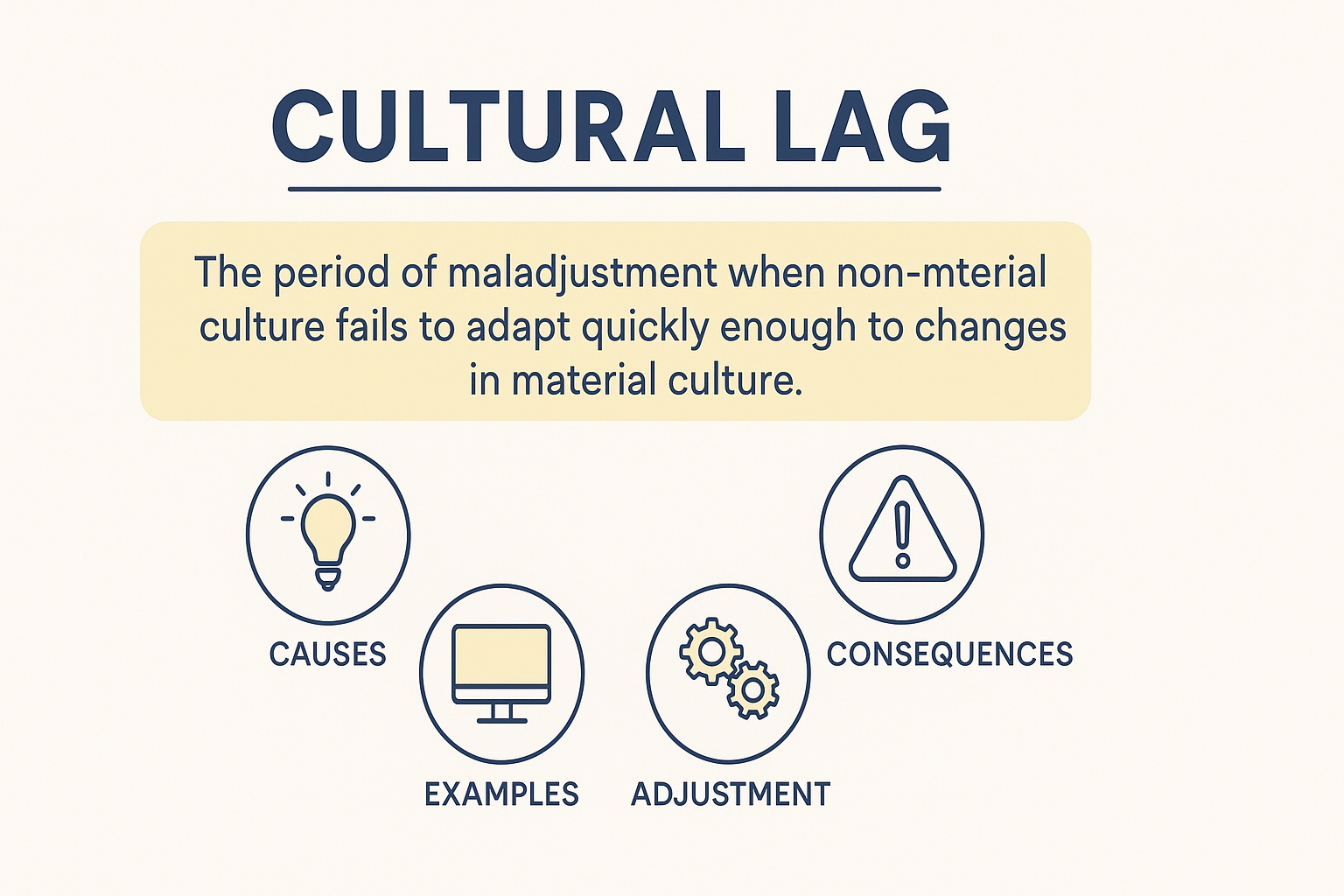Introduction
Societies are dynamic entities, constantly shaped by innovations, interactions, and historical transformations. Yet, cultural change does not always proceed uniformly. In sociology, this discrepancy between different aspects of culture is explained through the concept of “Cultural Lag.” The term, coined by sociologist William Fielding Ogburn in the early 20th century, highlights how material and non-material aspects of culture evolve at different speeds, creating tension, confusion, and adjustment problems within society.
In the modern world of technological revolutions, globalization, and social change, the concept of cultural lag has become even more relevant. Whether it is artificial intelligence, genetic engineering, or changing gender norms, the pace at which societies adapt socially and morally often lags behind the pace of material or technological progress.

This article explores the meaning, causes, consequences, and contemporary relevance of cultural lag in sociology.
Meaning of Cultural Lag
Cultural lag refers to the period of maladjustment when the non-material aspects of culture (values, norms, beliefs, laws, institutions) fail to adapt quickly enough to changes in material culture (technology, inventions, physical objects).
- Material culture includes tangible creations such as machines, tools, technologies, and infrastructure.
- Non-material culture includes intangible aspects such as morals, traditions, ideologies, and laws.
Ogburn argued that while material culture tends to change rapidly due to scientific and technological innovations, non-material culture takes time to adjust. This gap between the two creates a “lag” that leads to social conflicts, ethical dilemmas, and policy debates.
For example:
- The invention of in-vitro fertilization (IVF) created possibilities for childbearing, but laws and social norms about parenthood and inheritance took time to catch up.
- The rise of social media provided instant communication, but norms about privacy, mental health, and ethical use evolved much more slowly.
Thus, cultural lag represents a tension in the adaptive capacity of societies.
Historical Development of the Concept
The concept was first systematically introduced in William F. Ogburn’s book “Social Change with Respect to Culture and Original Nature” (1922).
- Ogburn emphasized that technological advancements (material culture) are primary drivers of social change.
- However, he observed that social institutions, values, and legal systems often resist rapid change, causing a time lag.
Ogburn’s idea became central to understanding industrialization, modernization, and the problems created by scientific innovations in society.
Later sociologists expanded the concept, showing that cultural lag is not merely technological but can also occur in domains like gender equality, environmental awareness, and globalization.

Causes of Cultural Lag
Several factors explain why cultural lag occurs:
- Rapid Technological Innovations
- Science and technology advance faster than laws or moral frameworks.
- Example: The invention of autonomous vehicles came before legal codes about traffic liability or accident responsibility.
- Deep-rooted Traditions and Values
- Non-material culture is embedded in collective conscience and is resistant to change.
- Example: Even after women’s education expanded, patriarchal attitudes toward women’s roles lagged behind.
- Institutional Inertia
- Legal and political institutions often take time to recognize, regulate, or respond to new realities.
- Example: Internet-based crimes grew faster than the establishment of cybercrime laws.
- Psychological Resistance
- People often resist change due to fear of the unknown, attachment to customs, or moral concerns.
- Example: Cloning technology faced widespread opposition due to ethical fears, despite scientific feasibility.
- Unequal Access to Technology
- Not all social groups adapt at the same pace due to inequalities in wealth, education, and geography.
- Example: Digital divide during COVID-19 online education created inequalities because rural and poor communities lagged in adopting digital tools.
Consequences of Cultural Lag
Cultural lag has wide-ranging implications for individuals, groups, and societies:
- Social Conflicts and Tensions
- Disagreements arise between those who adopt new technologies and those holding on to old values.
- Example: Conflicts over same-sex marriage laws in societies with rapid modernization but conservative cultural values.
- Moral and Ethical Dilemmas
- Innovations create ethical debates.
- Example: Genetic engineering and designer babies raise questions about morality and human rights.
- Policy and Legal Gaps
- Absence of updated legal frameworks allows misuse of technology.
- Example: Data theft and online harassment occurred long before effective cyber laws were enacted.
- Generational Divides
- Younger generations often adapt more quickly to new technology than older ones, leading to cultural gaps.
- Example: Elderly populations struggle with digital banking, while youth embrace cashless economies.
- Delayed Social Progress
- Societies may fail to fully benefit from new technologies due to slow cultural adaptation.
- Example: Renewable energy technologies exist, but fossil fuel dependence continues due to cultural and institutional lag.
Examples of Cultural Lag in Society
- Medical Technology
- Advances in organ transplantation and life-support machines raised questions about when death occurs—biological death vs. brain death.
- Information Technology
- Social media enabled free speech, but it also spread misinformation and hate speech faster than societies could regulate.
- Family and Reproductive Practices
- IVF, surrogacy, and sperm donation raised questions about family structures, legal guardianship, and parenthood.
- Gender and Sexuality
- Technological and educational opportunities increased for women and LGBTQ+ individuals, but patriarchal and heteronormative cultural values often lag.
- Environmental Issues
- Industrialization advanced rapidly, but awareness of environmental conservation, climate change, and sustainable development lagged, creating ecological crises.

Cultural Lag and Globalization
Globalization has intensified cultural lag by accelerating the diffusion of technology and ideas:
- Developed countries adopt innovations faster, while developing nations struggle with adaptation.
- Global exposure challenges traditional societies, creating conflicts between modern values and cultural heritage.
- Legal harmonization across countries lags, especially in issues like intellectual property rights, digital privacy, and climate policies.
For example, while cryptocurrencies gained global popularity, most national governments lagged in creating uniform regulations.
Criticism of the Concept
Though influential, the concept of cultural lag has faced criticisms:
- Technological Determinism
- Ogburn’s theory is criticized for overemphasizing technology as the main driver of change while underestimating human agency and cultural creativity.
- Not Always Linear
- Sometimes non-material culture also leads change, not just lags.
- Example: Feminist movements created demand for workplace equality, influencing technological adaptation.
- Overgeneralization
- Critics argue that not all societies experience the same lag; adaptation depends on historical, cultural, and economic contexts.
- Cultural Integration
- In some cases, material and non-material cultures adjust simultaneously, showing that lag is not inevitable.
Relevance of Cultural Lag in the 21st Century
In the modern era, cultural lag remains a powerful tool for analyzing social issues:
- Artificial Intelligence (AI): While AI transforms industries, ethical debates about employment, privacy, and bias lag behind.
- Climate Change: Technologies for renewable energy exist, but global policies and consumer habits lag.
- Digital Divide: Technology connects the world, but unequal access creates new forms of inequality.
- Biotechnology: CRISPR and gene editing raise moral dilemmas about altering human life.
- Work Culture: Remote working technologies exist, but corporate culture and labor laws often resist change.
The persistence of cultural lag shows the ongoing tension between innovation and adaptation.
Sociological Importance of Cultural Lag
From a sociological perspective, cultural lag is important because:
- It explains social disorganization during times of rapid change.
- It helps in policy-making by highlighting the need to update laws and institutions.
- It illustrates the interconnectedness of culture, showing how imbalance between its parts creates strain.
- It provides insights into social resistance, inequality, and modernization processes.
Conclusion
The concept of cultural lag remains one of sociology’s most significant contributions to understanding social change. William Ogburn’s insight—that technology often outpaces norms, values, and laws—continues to explain contemporary dilemmas, from AI to environmental crises.
Cultural lag is not merely about delay; it is about the tension between continuity and change, tradition and modernity, material advancement and moral adaptation. Recognizing and addressing cultural lag allows societies to better manage rapid transformations, ensuring that progress in one sphere is matched by progress in values, institutions, and ethical frameworks.
As humanity enters an age of exponential technological growth, the challenge of cultural lag becomes ever more pressing. The future of social harmony and sustainable development depends on how effectively societies bridge the gap between material and non-material culture.
Do you like this this Article ? You Can follow as on :-
Facebook – https://www.facebook.com/hubsociology
Whatsapp Channel – https://whatsapp.com/channel/0029Vb6D8vGKWEKpJpu5QP0O
Gmail – hubsociology@gmail.com
Topic Related Questions on Cultural Lag in Sociology
5 Marks Questions
(Answer in about 100 words each)
- Define cultural lag with reference to William Ogburn.
- Differentiate between material culture and non-material culture with examples.
- State any two causes of cultural lag.
- Give two examples of cultural lag in contemporary society.
- How does cultural lag create generational gaps?
10 Marks Questions
(Answer in about 250 words each)
- Explain the major consequences of cultural lag with suitable examples.
- Discuss the role of globalization in intensifying cultural lag.
- How does cultural lag affect law and policy-making in modern societies?
- Critically analyze Ogburn’s concept of cultural lag and its limitations.
- Examine the relationship between technological innovation and cultural lag in the 21st century.
15 Marks Questions
(Answer in about 400 words each)
- Discuss in detail the meaning, causes, and consequences of cultural lag with examples.
- Evaluate the relevance of cultural-lag in the 21st century with reference to AI, biotechnology, and environmental issues.
- “Cultural lag is not only technological but also social and moral.” Explain this statement with examples.
- Critically discuss Ogburn’s theory of cultural-lag. Do you agree that technological change is the primary driver of social change? Give reasons.
- Analyze the sociological significance of cultural-lag in understanding modernization and social disorganization.
